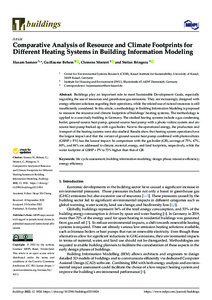| dc.date.accessioned | 2022-11-16T12:59:48Z | |
| dc.date.available | 2022-11-16T12:59:48Z | |
| dc.date.issued | 2022-10-31 | |
| dc.identifier | doi:10.17170/kobra-202211167127 | ger |
| dc.identifier.uri | http://hdl.handle.net/123456789/14250 | |
| dc.description.sponsorship | Gefördert durch den Publikationsfonds der Universität Kassel | ger |
| dc.language.iso | eng | ger |
| dc.rights | Namensnennung 4.0 International | * |
| dc.rights.uri | http://creativecommons.org/licenses/by/4.0/ | * |
| dc.subject | life cycle assessment | ger |
| dc.subject | building information modeling | ger |
| dc.subject | design phase | ger |
| dc.subject | resource efficiency | ger |
| dc.subject | energy efficiency | ger |
| dc.subject.ddc | 620 | ger |
| dc.subject.ddc | 624 | ger |
| dc.title | Comparative Analysis of Resource and Climate Footprints for Different Heating Systems in Building Information Modeling | ger |
| dc.type | Aufsatz | ger |
| dcterms.abstract | Buildings play an important role to meet Sustainable Development Goals, especially regarding the use of resources and greenhouse gas emissions. They are increasingly designed with energy-efficient solutions regarding their operations, while the related use of natural resources is still insufficiently considered. In this article, a methodology in Building Information Modeling is proposed to measure the resource and climate footprints of buildings’ heating systems. The methodology is applied to a case study building in Germany. The studied heating systems include a gas condensing boiler, ground-source heat pump, ground-source heat pump with a photo-voltaic system and air-source heat pump backed up with a gas boiler. Next to the operational energy, the production and transport of the heating systems were also studied. Results show that heating system operations have the largest impact and that the variant of ground-source heat pump combined with photovoltaics (GSHP + PV) has the lowest impact. In comparison with the gas boiler (GB), savings of 75%, 47%, 80%, and 84% are addressed to climate, material, energy, and land footprints, respectively, while the water footprint of GSHP + PV is 73% higher than that of GB. | eng |
| dcterms.accessRights | open access | ger |
| dcterms.creator | Sameer, Husam | |
| dcterms.creator | Behem, Guillaume | |
| dcterms.creator | Mostert, Clemens | |
| dcterms.creator | Bringezu, Stefan | |
| dc.relation.doi | doi:10.3390/buildings12111824 | |
| dc.subject.swd | Ökologischer Fußabdruck | ger |
| dc.subject.swd | Energieeffizienz | ger |
| dc.subject.swd | Umweltbilanz | ger |
| dc.subject.swd | Ressourceneffizienz | ger |
| dc.subject.swd | Building Information Modeling | ger |
| dc.subject.swd | Heizung | ger |
| dc.subject.swd | Deutschland | ger |
| dc.type.version | publishedVersion | ger |
| dcterms.source.identifier | eissn:2075-5309 | ger |
| dcterms.source.issue | Issue 11 | ger |
| dcterms.source.journal | Buildings | ger |
| dcterms.source.volume | Volume 12 | ger |
| kup.iskup | false | ger |
| dcterms.source.articlenumber | 1824 | |


